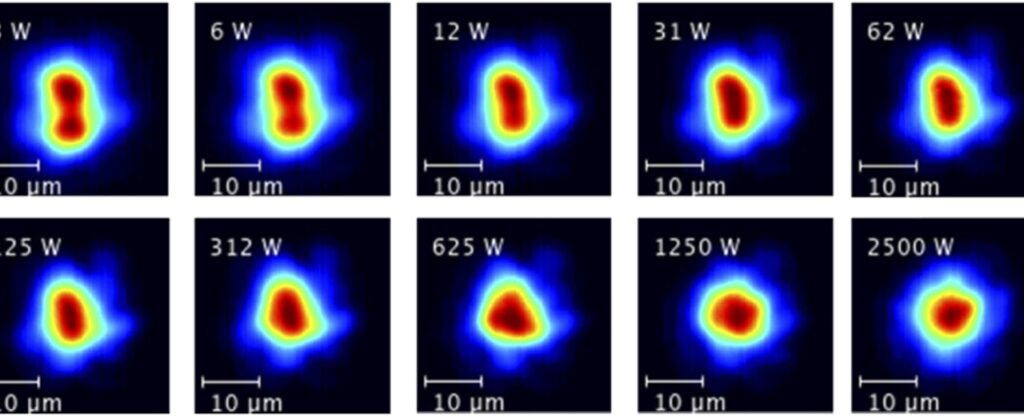Highly efficient few-mode spatial beam self-cleaning at 1.5µm
In applications where MMFs are used for beam delivery, an important problem to be solved is the effective coupling and stable transport of a diffraction limited optical beam from a single mode (SM) laser source into the fundamental mode of the MMF. Random mode coupling may limit the MMF length to a few tens of cm, before the beam quality is severely degraded.
Although in MMF amplifiers, an effective SM propagation can be achieved by gain-guiding, in passive graded-index (GRIN) MMFs spatial beam self-cleaning towards the fundamental, as well as different low-order modes, has been demonstrated in the normal group velocity dispersion (GVD) regime, by exploiting the intensity-dependent refractive index of the fiber, under excitation conditions involving a relatively large number (i.e., a few tens) of guided modes. The important question arises: is it still possible to observe a beam self-cleaning effect under few-mode excitation conditions, and for what input threshold powers?


To answer this question, we experimentally investigated the process of beam self-cleaning in GRIN-MMFs under the condition of few-mode coherent excitation. We obtained this condition by using a laser pump at 1562 nm, that is, within the telecom spectral window. We used long (160 ps), pre-chirped optical pulses. The use of such long pulses permits to neglect both modal and chromatic dispersion effects in their propagation over ∼10 m of GRIN MMF. Still, as we shall see, previously unforeseen, and highly efficient, spatiotemporal nonlinear attractors emerge from nonlinear multimode propagation in the MMF. We found that the pulse at the fiber output exhibits a very robust spatial reshaping into the fundamental LP01 mode (see Fig 1).
Figure 2 shows the observed progressive self-cleaning, as the input peak power grows larger, of the output near-field intensity patterns. As can be seen, the speckled output intensity pattern resulting from the coherent superposition of modes at a peak power of about 3 W, self-cleans into a bell-shaped beam, with negligible multimode field background, as the peak power grows higher than ∼100 W. We show in Fig.3 (solid curve) the intensity correlation Cs of the experimental near field pattern of the output beam with the mode LP01, numerically obtained with a mode solver.
Moreover, depending on the specific input spatial coupling conditions (i.e., the incidence angle of the beam), a beam self-cleaning in the odd low-order LP11 mode can also be obtained at the fiber output (see Fig.2). This effect may be interpreted as the generation of transient beam, before its eventual decay into the fundamental mode at longer distances. Even more remarkable is the high intensity correlation with the LP11 mode, reaching more than 80% at high powers, as illustrated by the green curve of Fig. 3.

The optimized, and nearly SM excitation conditions lead to highly efficient spatial beam self-cleaning. Namely, the power threshold for self-cleaning is reduced by one order of magnitude with respect to previous experiments carried out in the normal GVD regime, and based on highly multimode excitation.
In the presented demonstration, a GRIN optical fiber with a fundamental mode size close to that of a standard SM fiber was used, so that the SM and the MMF have a comparable power-carrying capability. This does not limit the power scalability of self-cleaned beam delivery: GRIN fibers exist with very large diameters up to 600 µm (and larger fiber diameters can be drawn, if needed). Thus, the fundamental mode of GRIN fibers can reach a diameter of more than 120 µm, which opens new potentialities for high-power delivery. In addition, the design of new optical fibers with a supergaussian index profile can relax the constraints on the fundamental mode area, while keeping the good efficiency of the Kerr self-cleaning effect.
Several applications, such as three-photon imaging in medical microscopy and endoscopy, high-power laser beam delivery for metal cutting and welding, mode-locked multimode fiber lasers and amplifiers operating in the near-infrared, and space-division-multiplexed transmissions with GRIN fibers could benefit from this new spatiotemporal self-reshaping phenomenon.
